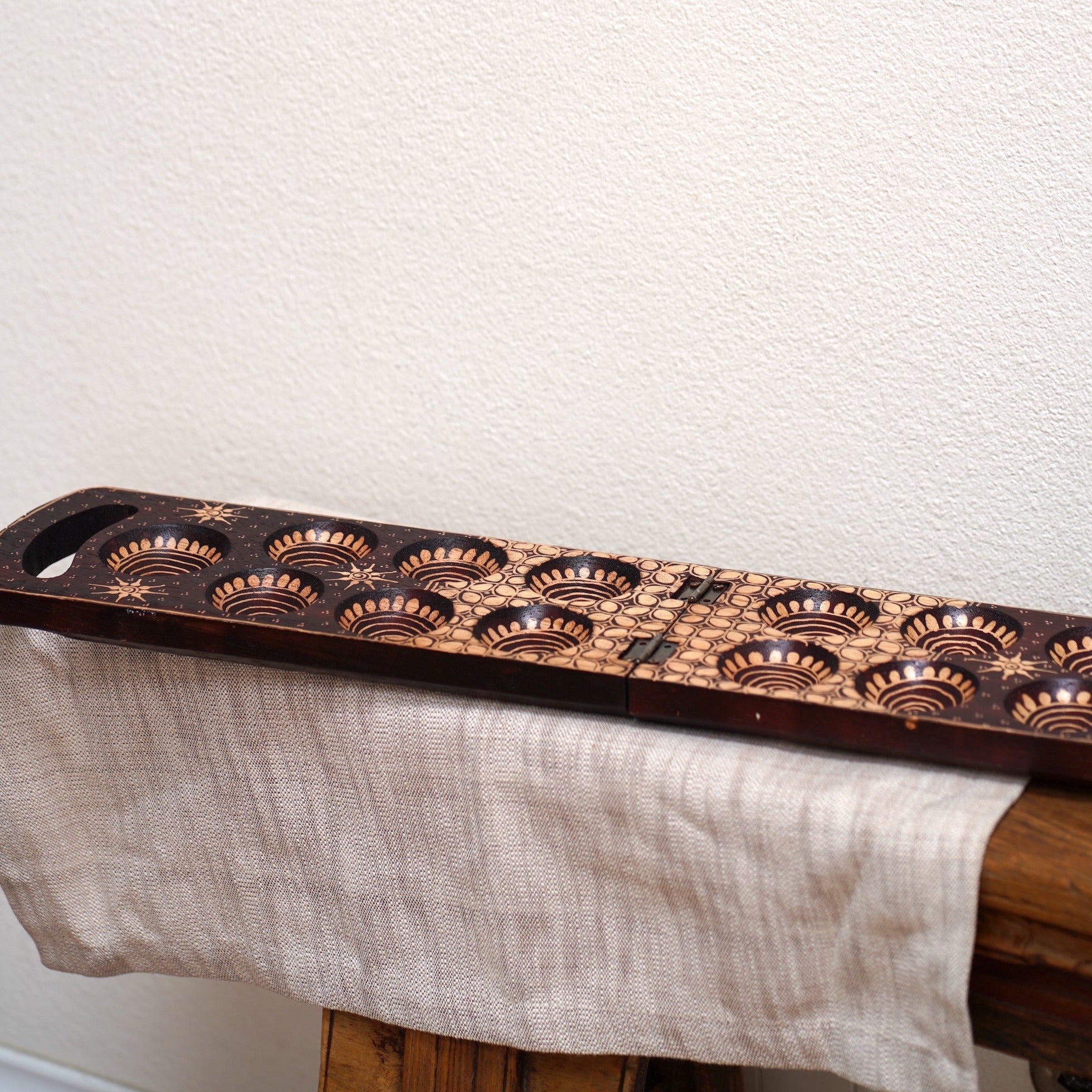Instructions for How to Play Congklak or Dakon or Mancala Board from Indonesia

Number of Players: 2
What you need: congklak board and 98 small shells, seeds or stones (for a board that has 7 holes on each side) or 72 small beads for a board that has 6 holes on each side.
Object of the Game: to get as many beads as you can into your store house. Your store house is the hole at the end of the board on your left side. We play the congklak game by distributing the shells/beads clockswise (to the left).
To Win: You win the game if you have the most beads in your store house - or - if you are the last person to run out of beads on your side of the board.
To Play - The First Round
Count 7 (or six of your board has only 6 holes) beads into each of the holes on your side of the board. Leave your store house (at the end) empty. (If your board has less/more than 7 holes on each side, fill each hole with playing pieces equal in number to the number of holes on one side of the board).
Decide who will go first.
The first player takes all of the beads out of any hole on their side of the board. Move clockwise around the board and drop one bead into each hole in an effort to reach your own storehouse at the end of the board. Do not drop a bead into your opponent's store house.
If the last hole into which you dropped a bead:
- Has beads in it - take all of the beads in that hole (even if it is in the opponents side) and put them in your store house and continue moving around the board just like you did in the beginning of the game.
- Is empty - leave your bead in that hole and end your turn. You are mati and it is now your opponent's turn.
- Is your store house - You get another turn. Take all of the beads out of any hole on your side of the board and continue to play moving around the board clockwise.
- Is empty + is on your side + you move gone around the board at least one time . Take this last bead, and all of the beads from your opponent's hole which is directly across from you, and put them all into your store house. It is now your opponent's turn.
After the first player's turn ends (mati), the opponent begins his/her turn and plays in the same manner.
The round ends when one player runs out of beads on his or her side of the board. If you run out of beads first (kalah jalan), your opponent wins the round (menang jalan). The winner of the round goes first in the next round.
Second Round
When one player has run out of beads, both players take all of their beads out of their store house, as well as any leftover beads from their side of the board.
Each player recounts the 7 beads into each hole on their side of the board, starting with the hole nearest your own store house (if you have 7 holes on your board; or 6 beads if you have 6 holes on your board). If one player has leftovers after putting 7 beads into each hole, they are menang biji and put all the extra beads back into their store house.
Since the losing opponent will not have enough beads to put 7 in each hole, they must ngacang, have some holes with less beads. This is done by filling in as many holes as possible with 7 beads, and splitting the remaining beads up amongst the remaining holes on their side of the board. The ngacang holes are the holes closest to the opponent's home. The number of ngacang holes will depend on the number of beads remaining after the previous round of play, but should never be more than 3 holes. Some ngacang holes may even be empty if you're really low on beads.
The ngacang holes become protected from your opponent in this round. As your opponent goes around the board, they must skip these holes, not dropping a bead in them. Neither player can take beads from these holes - but you can drop beads in your own ngacang holes. Ngacang beads are also protected from tembak if your opponent ends up in an empty hole across from them.
This is an important, strategic handicap, as the player who has at least one bead in her rightmost hole can always continue the jalan on her side of the board.
In the second and successive rounds, the person who begins play is the one who goes out of beads last (menang jalan) in the previous round.
End of the game
Play continues with successive rounds until one player loses all of their beads, or both players wish to stop playing, at which time you would count the beads to see who has the most, and is thus the winner.
While the game is simple enough, strategies develop with practice and skill that enable the player to maximize the chances of having at least one bead left in a position to carry on the journey and to create the opportunity to harvest the opponent's beads in a tembak.
Players with mathematical talents have an advantage, for the rules enable the player to determine in advance whether she will win or lose before selecting an odd or even numbered pile of playing pieces.
Featured Products
